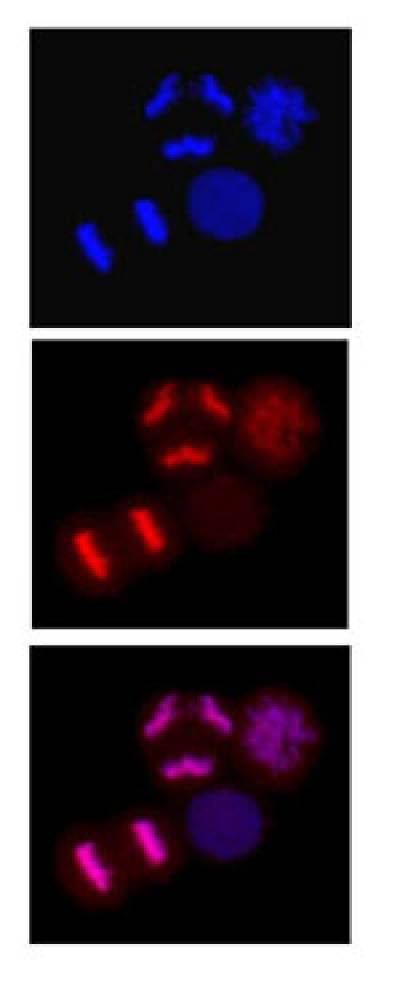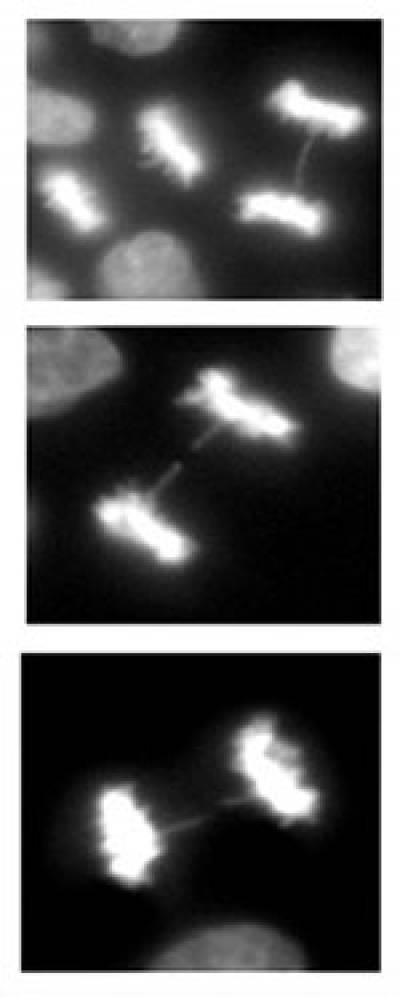Human SIRT1 is a NAD-dependent deacetylase that belongs to the conserved sirtuin family of proteins. It participates in cellular controls of gene expression, metabolism, genomic stability and anti-ageing. The roles of SIRT1 in cancer development are complex and still not well understood.
SIRT1-/- mice embryos show accumulation of cells in early mitosis and chromosome instability evident from chromosome lagging and unequal segregation despite a relatively normal spindle formation. Mitosis is subdivided into a number of phases during which the chromosomes are condensed and compacted, aligned on the metaphase plate and separated by the mitotic spindle pulling chromatids apart. Failure to properly condense chromatin leads to segregation problems that result in broken chromosomes and/or aneuploidy, or cell death.
Our recent data show that the protein levels of SIRT1 rise in early mitosis where it associates with global chromatin throughout M-phase from prometaphase to telophase. SIRT1 knockdown leads to improper condensation, failure to properly align chromosomes on metaphase plate, increased lagging chromosomes and overall aberrant mitosis. Furthermore, SIRT1 contributes to chromatin condensation by modulating chromatin loading of linker histone H1 and condensin I complex.
This new role of SIRT1 in the maintenance of chromosome stability during mitosis provides a mechanistic rationale to how diminished SIRT1 activity during ageing and tumorigenesis may lead to aneuploidy and genomic instability. On the basis of our data, we hypothesize that cells with reduced levels of SIRT1, such as cancer and ageing cells, can continue proliferation due to elevated SIRT1 levels in mitosis, thus enabling them to condense and segregate chromosomes in a relatively normal way. We believe that this could be a new and important survival mechanism for tumour cells, which may keep them relatively stable at the chromosomal level. Reduced levels of SIRT1 in mitosis, however, would increase the amount of chromosomal abnormalities and facilitate tumour progression.
Images on the right show SIRT1 association with mitotic chromatin in HeLa cells (SIRT1 in red, DNA in blue)), and chromatin anaphase bridges that form and brake when SIRT1 is depleted. Images were taken by Melissa Berto.
Figure 4. Working hypothesis: cancer cells with reduced levels of SIRT1 can continue proliferation by rising SIRT1 levels in mitosis. Lower than normal levels of SIRT1 in mitosis, however, would increase the amount of chromosomal instability (CIN) and facilitate tumour progression. Panels on the right show SIRT1 (red) associating with mitotic condensed chromosomes (blue). Top panel shows nuclei of cells with depleted SIRT1 at the prometaphase and anaphase stages of which one is abnormal with three centrosomes. Bottom panel shows anaphase chromosome bridges. Top section - normal anaphase segregaton (left side) and abnormal with chromosomes bridge (right side). Bottom two sections - chromosome bridges are snapped during anaphase to telophase transition.
 Close
Close



